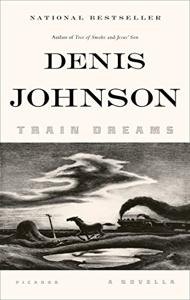
Want to learn the ideas in Train Dreams better than ever? Read the world’s #1 book summary of Train Dreams by Denis Johnson here.
Read a brief 1-Page Summary or watch video summaries curated by our expert team. Note: this book guide is not affiliated with or endorsed by the publisher or author, and we always encourage you to purchase and read the full book.
Video Summaries of Train Dreams
We’ve scoured the Internet for the very best videos on Train Dreams, from high-quality videos summaries to interviews or commentary by Denis Johnson.
1-Page Summary of Train Dreams
Overall Summary
The novella Train Dreams, by Dennis Johnson, was published in the Paris Review in 2002. It follows an orphan living in Idaho from 1890 to 1960. The author died of liver cancer in 2017 and is most well-known for his novel Tree of Smoke (2007), which won the National Book Award.
Train Dreams is about isolation, the closing of the American West, and perseverance in the face of fundamental alienation. The novella opens with a man named Robert Grainier who takes part in possible murder of a Chinese worker accused of stealing from a train service in northern Idaho. He and other men are going to throw him down a 60-foot waterfall but he escapes them by being nimble.
After the murder attempt, Grainier buys a soda for his wife and child. He takes on more risky jobs with the railroad gang to test out how well the brakes work over an incomplete bridge before it falls into a river.
Grainier takes on work cutting down trees. He enjoys being in the woods, but is warned by a veteran tree cutter that the woods aren’t friendly. The veteran tells him about an incident where a giant tree broke out of its strappings and rolled over six horses instantly killing them. He also talks about his experience working as a miner in Arizona and clearing paths through mountains and trees using dynamite.
Everyone is worried that Arne will die from an explosion, but he ends up dying when a large bough falls on his head. He dies a few days later. During the funeral, people think about how hardworking and honest he was. The lumbermen are sad to see him go because they need spruce wood for WWI (World War I).
The story flashes forward to 1962 (or 1963). He watches younger men build the highways that will mark up the nation. In achronological order, he also thinks about seeing the Fattest Man in The World at a fair in the 1950s and running into Elvis Presley in 1927.
Chapter Three is about Grainier’s life in Fry, Idaho. He arrived there as an orphan at the age of 7 and was raised by his aunt. At that time, the towns of Fry and Eatonville consolidated to form Bonners Ferry. Grainier attended school in Bonners Ferry until he was a preteen; then he quit school and took on odd jobs for a while before settling into fishing alone.
Grainier has a good reputation for being honest and making good on his promises. He is also known to not drink liquor, which was important in the 1920s because of Prohibition. He meets Gladys at church and they have a summer romance before getting married. One day he comes home to find that his property burned down, presumably killing them both. Grainier searches around the area but finds no sign of them except for one day when he saw what looked like Gladys’ bonnet blowing in the wind (but this may have been just another delusion).
Over time, the animals return to the valley and plants regrow after a fire. In fact, two seasons later, Grainier realizes that it’s beautiful again. He builds another cabin using stone foundations.
While Grainier is reconstructing his cabin, he befriends a Kootenai Indian who goes by the name of Bob. Years go by and Grainier doesn’t hear anything more about Bob until one day when he hears that Bob has died after drinking lemon juice because people told him it would cure alcohol poisoning. This made him drunk and caused him to wander onto train tracks where he was hit by several trains in succession.
The narrative then skips to four years after the death of Gladys and Kate, when Grainier is still having nightmares about them. He adopts a large, male dog who serves as his loyal companion for many years. The narrator says that Grainier never saw the ocean, though he travels to several locations in the western U.S., including San Francisco and Alaska. Then, in November 1968, Grainier dies in his sleep at age 78; nobody thinks to search for him because there’s no one left to miss him. Nearly a year passes before some hikers notice a smell coming from an abandoned cabin where Grainier died; they call a doctor who writes up a death certificate and buries him without anyone knowing about it until months later when people start asking questions about why he’s been missing for so long.





